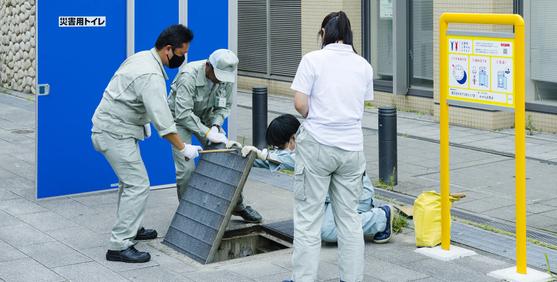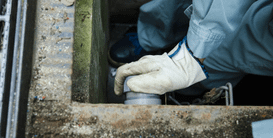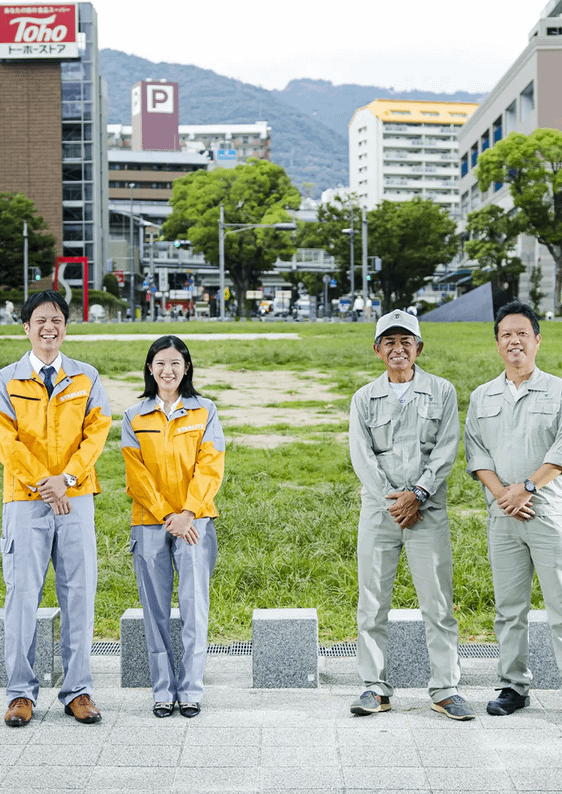
On Your Side Vol.6KOBE City Government
KOBE City × Emergency Toilet The “FUNCTION” developed by “MUTUAL SUPPORT” with KOBE City has elevated emergency toilets to more hygienic, secure and safer toilets that are essential for evacuation centers, and they continue to spread as a standard.
The emergency toilet co-developed by Kobe City and Starlite. Its “safety and hygiene level” has given a great sense of relief to the life in evacuation centers. The key is our “Quickhouse and Manhole Toilet,” and we will deliver our behind-the-scenes story.
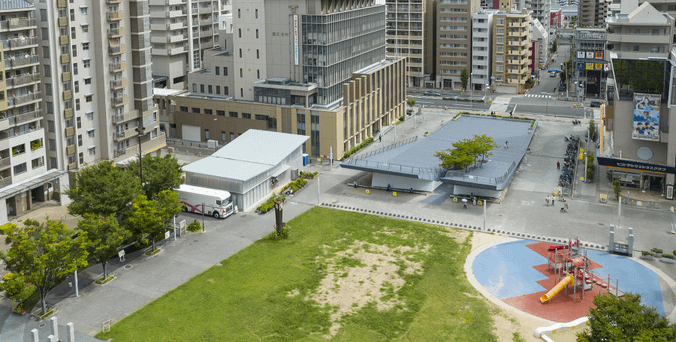
“Quickhouse and Manhole Toilet”
Our Quickhouse and Manhole Toilet is a strong emergency toilet for stockpiling and has been developed to provide peace of mind in evacuation centers. Not only is it thin for long-term stockpiling and for transportation in times of emergency, but also it is easy to assemble. Furthermore, hygienic and safety features were applied based on the lessons from the Great Hanshin-Awaji earthquake.

Its auto-flap bar will operate even with a small amount of water, and it can be used securely for a long period of time in times of emergency.

On Your Side Vol.6 KOBE City × STARLITEInterview with our Customer
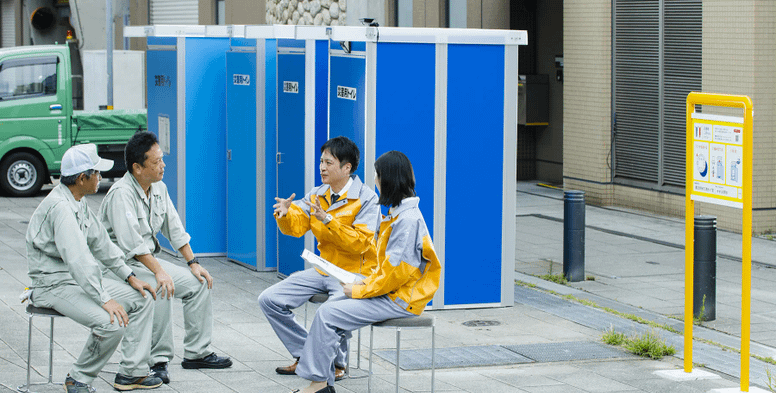
KOBE City: Mr Toso“What is required in evacuation centers now are emergency toilets designed with the safety and privacy of women and children in mind.”
Starlite: OmoyaThank you very much for taking your valuable time for this interview today. I have been looking forward to this interview on emergency toilets with KOBE City, which has been proactively engaging in disaster prevention initiatives ever since the Great Hanshin-Awaji Earthquake. I also would like to thank KOBE City for using our “Quickhouse & Manhole toilets” after the earthquake.

Starlite: HanaokaNice to meet you. I am Hanaoka in Marketing Department and am a resident of KOBE City. I was born and raised in KOBE. Today’s interview is held in a park in my local neighborhood, so I feel today’s “emergency toilets” theme very close. I am very keen to hear about stories behind the “emergency toilets.” I am of the generation born after the Great Hanshin-Awaji Earthquake, so from an early age, I heard numerous stories from my parents who were affected by the quake. This park is an open space with a view of Mt. Rokko, but this is also where a condominium collapsed in the earthquake... I have mixed feelings about it.
KOBE City: Mr TosoWe have also been looking forward to this opportunity to re-think about emergency toilets. Hanaoka san is a “KOBE City citizen”, so I would like to inform you of our efforts in detail.
The earthquake caused a lot of damage, including collapsed buildings, and there were also many heartbreaking incidents. We sympathize with your feelings. KOBE City does not want another disaster like the Great Hanshin-Awaji Earthquake to happen again and we are committed to developing an earthquake-resistant community. What we have done first was to increase the number of new facilities equipped with evacuation functions such as this park to ensure safe evacuation centers.

What do you think we need first after opening evacuation centers due to a disaster? The answer is toilets. We have stockpiled various emergency goods including emergency toilets at 149 designated evacuation points such as elementary and junior high schools and parks within KOBE City. For the toilets alone, we have installed 60 toilet bases capable of setting up 290 portable manhole toilets*1 that can be connected to the public sewers. This equates to one toilet for every 250 people as an initial response to a disaster and one toilet for every 100 people after the initial response.
1 Portable manhole toilets connected to public sewers
- Sewerage pipes for temporary flush toilets are laid in advance. In the event of a disaster, emergency toilets are assembled and placed above manholes fitted to the sewerage pipes. Human waste is discharged directly into the sewer. This eliminates the need for the collection of human waste and maintains clean toilet environments.
Furthermore, KOBE City estimates that, if a huge Nankai Trough earthquake were to occur, 44,115 evacuees would be expected at peak times, a person would need to use the toilet five times a day, and the approximate usage of the toilets in a two-week period would be 2 million times. We are converting Japanese-style toilets to Western-style toilets at evacuation centers and ensuring that we provide safe and secure toilet environments with the safety and privacy of women and children in mind. In addition, disaster drills are held every year, and we provide opportunities for participants to assemble an actual emergency toilet. Here we stockpiled five of Starlite’s manhole toilets.
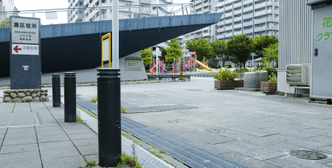














As well as providing material supplies, it is important to provide non-material services. In the event of a disaster, it is important to connect not only with people in the affected areas but also with those who have not been affected by the disaster. KOBE City communicates the importance of ‘Public help, Self-help, Mutual help*2’ connections on its website and through various media.
2 “Public help, self-help, mutual help”
- Public help is aid from the government, self-help is efforts of individuals for disaster prevention, and mutual help is mutual assistance through connections in society.

KOBE City: Mr IrisaThis is Irisa. Nice to meet you. Ever since the Great Hanshin-Awaji Earthquake, we have been experiencing big earthquakes across Japan such as the Great East Japan Earthquake. Due to the increasing number of damage caused by large-scale typhoons and flooding by torrential rain, the Ministry of Land, Infrastructure and Transport and Tourism and the Japan Meteorological Agency have actively started calling for actions with evacuations in mind. KOBE City has prepared hazard maps and often calls for evacuation to shelters, however, the reality is that our initiatives have not led to evacuation actions.
I was affected by the Great Hanshin-Awaji Earthquake in Nishinomiya City nearby here. I have children around Hanaoka san’s age. I share stories about the earthquake since they were little because I want them to be prepared for disasters as much as possible.
Starlite: Omoya“Being able to use toilets hygienically at evacuation centers will lead to the prevention of disaster-related deaths.”
Starlite: HanaokaI have heard stories about the earthquake since I began to understand things. The earthquake occurred early morning, most people went to evacuation centers with nothing but clothes on their backs, nearby elementary schools were used as shelters but there were long lines for the toilets, and evacuees could not flush the toilets due to water outages, etc. I heard hygiene-related issues were very serious. Furthermore, the water outages lasted for a few weeks…. It means that you could not use the toilet freely during that period, doesn’t it?! How did you manage that?
KOBE City: Mr TosoWe, the affected people, felt the same way at that time. The rate of the households using flush toilets was so high with 97 percent in KOBE that we had only five septic tank trucks in the city and no emergency toilet stockpile.
Soon after the earthquake, we requested 3,000 emergency toilets and septic tank trucks nationwide. Supporters and volunteers arrived in KOBE, and emergency vehicles came from all over the country. But debris scattered around major roads. All the arrivals caused heavy traffic jams throughout the day and night for several days. As you can expect, the installation of emergency toilets and waste collection by septic tank trucks were very slow. Human waste at evacuation centers and public parks piled up during that period, making the situation even worse, and the health damage of the affected people increased quickly.

Starlite: OmoyaSanitary conditions that prevent people from washing their hands and cleaning toilets, let alone not being able to use the toilet, cause health problems and infectious diseases, leading to an increase in the risk of outbreaks of disease clusters. When the toilet is not hygienic, victims avoid drinking water so that they do not need to go to the toilet. This could result in the loss of life due to dehydration, blood pressure increase, bladder inflammation, and economy-class syndrome. Ensuring a safe toilet environment is an important subject that can help prevent disaster-related deaths.

When my colleague Koyama, who was in charge of the development of public toilets at Starlite, heard about the problems with the toilets at evacuation centers, he was seriously concerned. He started visiting the centers with water and bags and collecting piles of human waste. Koyama was not the only one. Many volunteers did the same. Thinking back, the hygiene of the volunteers is worrying, but at that time there was no other way. As time passed, we began to receive many suggestions/feedback at the evacuation centers, which drove us to work with KOBE city to develop new-type of emergency toilets.
KOBE City: Mr Irisa“Manhole toilets are the toilets that reflect the voice of victims.”
KOBE City: Mr IrisaThis is what Koyama san recorded back then, and this is an article about the development of manhole toilets featured in a newspaper. As mentioned in the article, the advantage of the manhole toilets is they are hygienic. The water that comes in from this pump here flushes human waste stored in the pipe connected to the sewage. The toilets are designed to use swimming pool water or rainwater, so toilets can be used hygienically without any problems even if the water supply is cut off during a disaster.

The auto flap can stop bad smells. Simple toilets are designed to solidify stored human waste with a coagulant agent, and the waste is collected in bags. In KOBE city, these simple toilets and coagulant agent are stockpiled in locations where the manhole toilets cannot be installed. As you can see in Koyama san’s document, “Quickhouse” is the emergency toilet that reflects the voice of victims. It is very strong and secure.
The “auto-flap” – the flap opens when a certain amount of water is stored. Quickhouse is foldable and thin, so it was very easy to transport. Moreover, Quickhouse is available for wheelchair users and children, so evacuees were very pleased. We can recommend Quickhouse with confidence because smells are controlled and it is secure even for nighttime usage.

Starlite: OmoyaI am very pleased to hear that. I heard that the transportation of all emergency toilets started two days after the earthquake. I was very impressed with KOBE city’s risk management system and its mobile power led by the Risk Management Office.
KOBE City: Mr TosoWe experienced the Great Hanshin-Awaji Earthquake. That is why we feel the pain and hardship of the affected areas as if they were our own, and that must be what drives us. It is encouraging when young people like Hanaoka san take an interest. I feel that it is our responsibility to convey the importance of “public help, self-help and mutual help” in various ways to raise disaster prevention awareness of future generations. The Risk Management Office reflects feedback and findings from our initiatives in the “KOBE City Disaster Prevention Plan” and reviews the contents every year. We also actively send information via various media.
KOBE City: Mr IrisaThe objective of “Bosai Kokutai*3” is the extension of this. KOBE City has always conveyed memories of the Great Hanshin-Awaji Earthquake and worked on the reconstruction of the city. We need to be prepared for future disasters based on the learnings from past experiences. We would like to promote not only public help by the government but also self-help, in which each individual take part in disaster prevention, and mutual help, in which people help each other through their social ties. We will try to reiterate to as many people as possible the importance of raising disaster prevention awareness.
3 “Bosai Kokutai(National Convention on the Promotion of Disaster Reduction)”
- In March 2015, the importance of self-help and mutual help was recognized internationally in the Sendai Framework for Disaster Risk Reduction 2015-2030 adopted at the Third United Nations World Conference on Disaster Risk Reduction. This led to the establishment of the National Conference on the Promotion of Disaster Reduction. Since 2016, the Cabinet Office in charge of disaster reduction has been organizing “Bosai Kokutai” every year to raise awareness for disaster risk reduction as a nation in cooperation with the National Conference on the Promotion of Disaster Reduction and the Disaster Prevention Promotion Council. The year 2022 marks the 20th anniversary of the opening of the Great Hanshin-Awaji Earthquake Memorial Disaster Reduction and Human Renovation Institution (DRI). “Bosai Kokutai” will be held with the DRI as a hub. The event will be an opportunity to present a new model for networking and knowledge sharing throughout the country.

Starlite: Hanaoka“I want to convey the heartfelt voice of victims ‘It is important to be prepared.’”
Starlite: HanaokaThere were many people from overseas living in KOBE at the time of the earthquake, and many of those were affected. I feel that we can add positive effects on overall shelter life if we can add the perspectives of non-Japanese people.
Starlite: OmoyaWhat we learned from the Great Hanshin-Awaji Earthquake is that a lot of concerns relating to the toilet can be solved by “emergency toilet stockpile” “manhole toilet installations” and connections through “public help, self-help and mutual help.” We ensure that we stockpile “safe and sufficient numbers of toilets” nationwide before a disaster strikes.As Hanaoka mentioned, “public help, self-help and mutual help” are also very important.
Even for a short period of time, the unfamiliar environment in the evacuation center can be stressful, and stress will accumulate day by day. I feel that there are still many possibilities to support a more comfortable life in evacuation centers through emergency toilets. I am reminded that the pursuit of “even safer emergency toilets” has only just begun.

KOBE City: Mr TosoStarlite participates in disaster drills and collects feedback from residents. You are also promoting the signing of disaster prevention agreements with local governments across the country and installing manhole toilets on site. It shows how serious you are about promoting emergency toilets. I strongly felt in today’s interview that life in evacuation centers could be dramatically changed by pursuing the comfort of emergency toilets. Omoya san, I look forward to further developments of “even safer emergency toilets.”

Starlite: HanaokaI learned a lot about the actual toilet environment after the earthquake. It is important to stockpile a necessary number of emergency toilets for a comfortable life in evacuation centers, and manhole toilets are much more hygienic. I hope they will become more and more popular. I also hope the heartfelt voice of victims “it is important to be prepared” will reach the rest of the country. Perhaps, it is our generation that must actively convey the importance of this. I will share the toilet information with my family and friends :) Also, I will reconfirm evacuation methods and evacuation centers with my family based on the hazard map.
KOBE City: Mr IrisaHanaoka san’s generation is very good at sharing information using SNS. Please do share the importance of emergency toilet stockpiles across Japan. We also need to do more!
Starlite: OmoyaWe believe that emergency toilets have the potential to bring comfort and peace of mind to life in evacuation centers through the creation of “comfortable emergency toilet space.” We will continue to support safer, more secure and comfortable living through our functions and services. Thank you very much for your time today.

[Editorial Note] From tangible to intangible!? Findings from the training
The local fire brigade and victims of the earthquake who saw the manhole toilets set up in the evacuation centers praised the toilets as “a very innovative solution to the problem of the toilets in evacuation centers.” I was very pleased to hear that. On the other hand, there were some doubts as to whether the system could actually be used during disaster without any training.
Delivering toilets is not enough. We need to provide hands-on training!
As expected, opening the manhole lid and assembling a Quickhouse were easy, however, when we tried to “draw groundwater from the water storage tank for the manhole toilets,” it was tricky even with a specialist present. This may not work in the event of an earthquake… With this in mind, Starlite will call on local governments and ministries to plan, propose and promote practical training for setting up manhole toilets together with residents.
